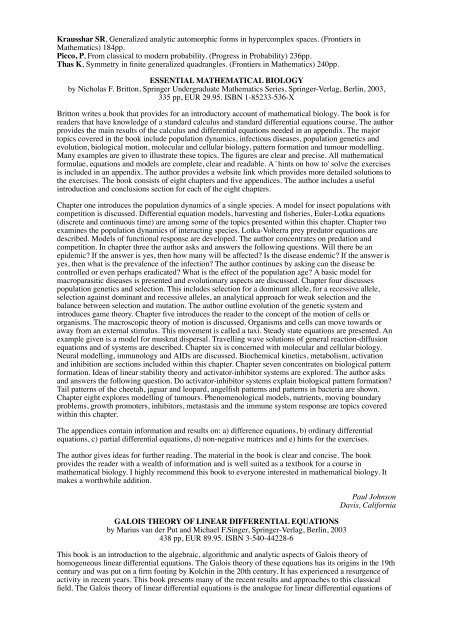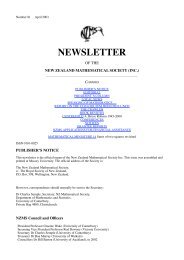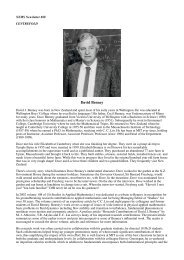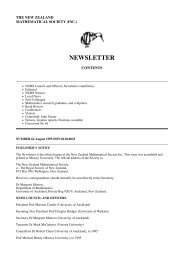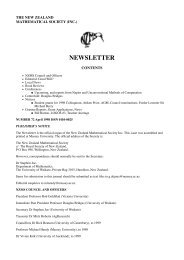newsletter - New Zealand Mathematical Society
newsletter - New Zealand Mathematical Society
newsletter - New Zealand Mathematical Society
You also want an ePaper? Increase the reach of your titles
YUMPU automatically turns print PDFs into web optimized ePapers that Google loves.
Krausshar SR, Generalized analytic automorphic forms in hypercomplex spaces. (Frontiers in<br />
Mathematics) 184pp.<br />
Picco, P, From classical to modern probability. (Progress in Probability) 236pp.<br />
Thas K, Symmetry in finite generalized quadrangles. (Frontiers in Mathematics) 240pp.<br />
ESSENTIAL MATHEMATICAL BIOLOGY<br />
by Nicholas F. Britton, Springer Undergraduate Mathematics Series, Springer-Verlag, Berlin, 2003,<br />
335 pp, EUR 29.95. ISBN 1-85233-536-X<br />
Britton writes a book that provides for an introductory account of mathematical biology. The book is for<br />
readers that have knowledge of a standard calculus and standard differential equations course. The author<br />
provides the main results of the calculus and differential equations needed in an appendix. The major<br />
topics covered in the book include population dynamics, infectious diseases, population genetics and<br />
evolution, biological motion, molecular and cellular biology, pattern formation and tumour modelling.<br />
Many examples are given to illustrate these topics. The figures are clear and precise. All mathematical<br />
formulae, equations and models are complete, clear and readable. A `hints on how to' solve the exercises<br />
is included in an appendix. The author provides a website link which provides more detailed solutions to<br />
the exercises. The book consists of eight chapters and five appendices. The author includes a useful<br />
introduction and conclusions section for each of the eight chapters.<br />
Chapter one introduces the population dynamics of a single species. A model for insect populations with<br />
competition is discussed. Differential equation models, harvesting and fisheries, Euler-Lotka equations<br />
(discrete and continuous time) are among some of the topics presented within this chapter. Chapter two<br />
examines the population dynamics of interacting species. Lotka-Volterra prey predator equations are<br />
described. Models of functional response are developed. The author concentrates on predation and<br />
competition. In chapter three the author asks and answers the following questions. Will there be an<br />
epidemic? If the answer is yes, then how many will be affected? Is the disease endemic? If the answer is<br />
yes, then what is the prevalence of the infection? The author continues by asking can the disease be<br />
controlled or even perhaps eradicated? What is the effect of the population age? A basic model for<br />
macroparasitic diseases is presented and evolutionary aspects are discussed. Chapter four discusses<br />
population genetics and selection. This includes selection for a dominant allele, for a recessive allele,<br />
selection against dominant and recessive alleles, an analytical approach for weak selection and the<br />
balance between selection and mutation. The author outline evolution of the genetic system and<br />
introduces game theory. Chapter five introduces the reader to the concept of the motion of cells or<br />
organisms. The macroscopic theory of motion is discussed. Organisms and cells can move towards or<br />
away from an external stimulus. This movement is called a taxi. Steady state equations are presented. An<br />
example given is a model for muskrat dispersal. Travelling wave solutions of general reaction-diffusion<br />
equations and of systems are described. Chapter six is concerned with molecular and cellular biology.<br />
Neural modelling, immunology and AIDs are discussed. Biochemical kinetics, metabolism, activation<br />
and inhibition are sections included within this chapter. Chapter seven concentrates on biological pattern<br />
formation. Ideas of linear stability theory and activator-inhibitor systems are explored. The author asks<br />
and answers the following question. Do activator-inhibitor systems explain biological pattern formation?<br />
Tail patterns of the cheetah, jaguar and leopard, angelfish patterns and patterns in bacteria are shown.<br />
Chapter eight explores modelling of tumours. Phenomenological models, nutrients, moving boundary<br />
problems, growth promoters, inhibitors, metastasis and the immune system response are topics covered<br />
within this chapter.<br />
The appendices contain information and results on: a) difference equations, b) ordinary differential<br />
equations, c) partial differential equations, d) non-negative matrices and e) hints for the exercises.<br />
The author gives ideas for further reading. The material in the book is clear and concise. The book<br />
provides the reader with a wealth of information and is well suited as a textbook for a course in<br />
mathematical biology. I highly recommend this book to everyone interested in mathematical biology. It<br />
makes a worthwhile addition.<br />
GALOIS THEORY OF LINEAR DIFFERENTIAL EQUATIONS<br />
by Marius van der Put and Michael F.Singer, Springer-Verlag, Berlin, 2003<br />
438 pp, EUR 89.95. ISBN 3-540-44228-6<br />
Paul Johnson<br />
Davis, California<br />
This book is an introduction to the algebraic, algorithmic and analytic aspects of Galois theory of<br />
homogeneous linear differential equations. The Galois theory of these equations has its origins in the 19th<br />
century and was put on a firm footing by Kolchin in the 20th century. It has experienced a resurgence of<br />
activity in recent years. This book presents many of the recent results and approaches to this classical<br />
field. The Galois theory of linear differential equations is the analogue for linear differential equations of


